Ghan Indian Pacific, Australia – Travel Review
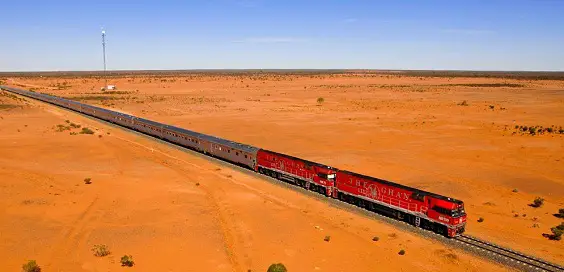
Felix Lowe explores Australia’s interior aboard the Ghan and Indian Pacific
Hypnotising horizons, chinking cutlery, scenic sights, fabulous food and woody wines. Just a handful of regular occurrences on either three-day rail crossing of Australia. Rather than a mere means of transport, this is ostensibly ‘rail cruising’. Where the holiday is as much the journey as it is getting to your destination.
Run by Great Southern Rail, The Ghan and Indian Pacific – the world’s only two transcontinental services – link Darwin and Adelaide (north to south) and Sydney and Perth (east to west). They take passengers across Australia’s Red Centre via the tropical Top End and sweeping plains. Or they go through the Blue Mountains and over the mesmerising Nullarbor Plain.
If you want to discover more about the real Australia – while watching its contours fly by as you sit back, socialise, eat, drink and be merry – then either one of these services are just the tonic. I should know. In the past year I have clambered aboard both iconic coast-to-coast trains.
“Love affair with the track”
The Ghan: a Town Called Alice
If travelling the three-day, two-night 1,846-mile journey in the direction of Darwin from Adelaide you’ll witness the agricultural lands of South Australia morph into the majestic Flinders Ranges and then the mythical Outback. Here blood-brown earth contrasts sublimely with cobalt blue skies. As the 750-metre, 30-carriage behemoth rolls into sleepy Alice Springs your jaw drops at the lofty MacDonnell Ranges.
The second half of the trip showcases the varied tropical wonders of the Northern Territory. The Ghan – named after the Afghan cameleers who once traversed the route – passes through Katherine. Famed for its astonishing Nitmiluk sandstone gorge, it then arrives at its final destination.
Whistle Stop tours at both Alice and Katherine allow passengers to take on a variety of activities. These include canoeing, camel riding, bushwalking or even scenic helicopter rides. Our Nitmiluk boat trip is breath-taking. It builds upon the excitement that stems from hours of addictive window gazing.
So enthralled am I by the subtly changing countryside, the captivating desert-scape and the rolling ranges, that both mornings I set my alarm for dawn to renew my curious love affair with the track’s surroundings. I watch the sun rise over the arid red soils of the barren yet beautiful Outback and the salt flats of Australia’s intriguing interior.
“Vast, sparse, pancake-flat”
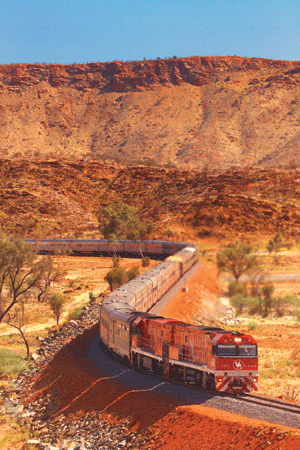 The Indian Pacific: the Road is Long
The Indian Pacific: the Road is Long
Crossing three states in three days and three nights, the mammoth 2,698-mile ride from Sydney to Perth packs an instant punch. The train takes in the Blue Mountains before weaving through the lush New South Wales countryside. The next morning you pass through the offbeat, bushland oasis of Broken Hill, Australia’s oldest mining town.
But the unique selling point of the Indian Pacific – which was completed in 1970, some 34 years prior to The Ghan – is the crossing of the beguiling Nullarbor Plain. The famous Blueys and the undulating hills that surround both Adelaide and Perth could hardly contrast more with the vast, sparse, pancake-flat Nullarbor (Latin for ‘no trees’). Here the train careers for almost 300-miles without so much a kink in the track.
Landmarks are few and far between either side of the world’s longest stretch of straight railroad. Although the stop-off in Cook (population: four) proves a real delight. Once a bustling railway settlement with a country club boasting a swimming pool, tennis courts, cricket nets and a nine-hole golf course, this South Australian oddity has fallen into desert and disrepair. A gift shop remains, run by the two ladies of the ghost town. While the odd sign reminds visitors of the place’s heritage: “If you’re a crook, come to Cook” says one. “Our hospital needs your help – get sick” says another.
“Hearty lunches and three-course dinners”
Across the Nullarbor and well into Western Australia, the gold mining town of Kalgoorlie offers travellers another chance to stretch their legs. A bus tour delves into the town’s swashbuckling Wild West-style history. It takes in two major sites: the immense open-top mine and strangely sterile red-light district.
Life Onboard: a Medley of Meals
Over the course of both journeys I become very familiar with the Queen Adelaide Restaurant and Outback Explorer Lounge. These are the communal areas for Platinum Service (high-end) and Gold Service (shared or single cabin) passengers. Damien the affable bartender never fails in his recommendations of local Pinots and Merlots. He revels in the chance to chew the fat about English football. Like many Australians, he used to live in Fulham.
The constant momentum is wonderfully somnolent when it comes to hitting the sack. While the jingle of knives and forks and the tingle of glasses creates a perfect symphony with which to accompany your many meals. Breaking up the day delightfully, these meals rarely disappoint. A full “Aussie” or continental breakfast in the morning, hearty lunches and three-course dinners in the evening. They feature classics such as saltwater barramundi, grilled kangaroo fillets and Tasmanian sea trout. How the chefs cope in one of the world’s tiniest professional kitchens with all the rumbling and swaying is anyone’s guess.
“Remote communities”
Around 65,000 passengers ride each train per year in basic Red Service reclining chairs or compact Gold cabins. Discerning travellers can enjoy deluxe Platinum, which includes double or twin beds, spacious en suite surroundings and on-call cabin service. The Gold fold-down beds pose no problem for this six-foot-five writer. While the ingenious bathrooms – where toilet and basin fold down into a tiny compact space that doubles up as a shower – are a hoot.
Special Services: Santa and Soldiers
Both trains share one stretch of track between Adelaide and the junction at Tarcoola. This is a small town north of Port Augusta (“the crossroads of Australia”). Bar the route, the only differences between the services are the locomotives (red for The Ghan, blue for the Indian Pacific) and the interchangeable logos on the sides of the carriages (a camel and an eagle respectively).
Every December the Indian Pacific runs a special Outback Christmas train. It spreads festive cheer to the remote communities along the route. Running for the past 11 years, the popular event features a series of concerts with a big-name star as well as seemingly incongruous desert and bush appearances from Santa Claus himself. The Ghan also operates a special service in late April, when it commemorates the Australian and New Zealand armed forces with a stirring ANZAC memorial ride.
“A staggering journey”
Besides the compelling geographical changes that greet your gaze, The Ghan and Indian Pacific also help you brush up on your Australian wildlife. On both trips I notice numerous kangaroos, wallabies and emus, not to mention hovering birds of prey and livestock. Keep an eye out for wild camels too. Australia has the only feral herds of dromedaries in the world, with numbers estimated at well over a million.
In fact, without the help of these camels neither The Ghan nor the Indian Pacific would have ever been built. More food for thought as you while away the hours slowly getting closer to your destination. A destination which you appreciate far more by virtue of the staggering journey you have experienced en route.
Great Southern Rail: gsr.com.au
The Ghan operates between Adelaide and Darwin (and vice versa) weekly all year and twice weekly June, July and August.
The Indian Pacific operates between Sydney and Perth (and vice versa) weekly all year and twice weekly September-late October.
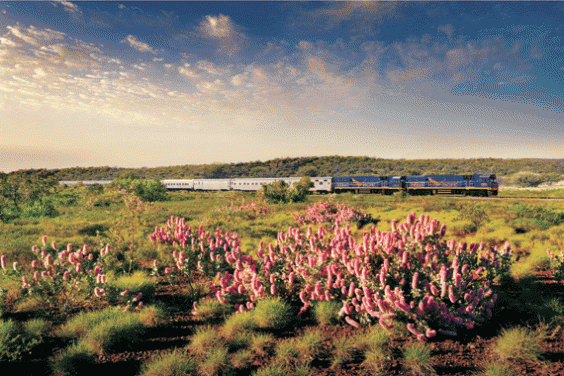
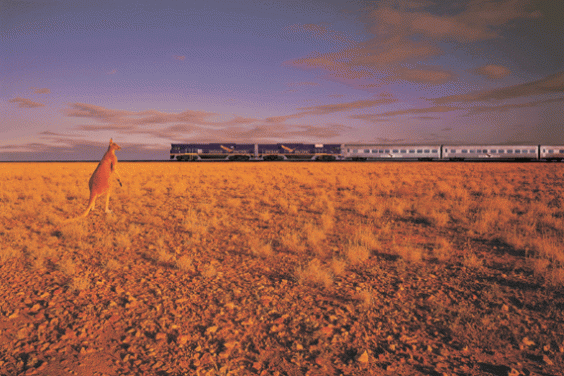
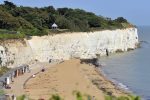
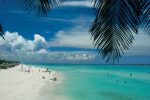
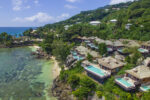
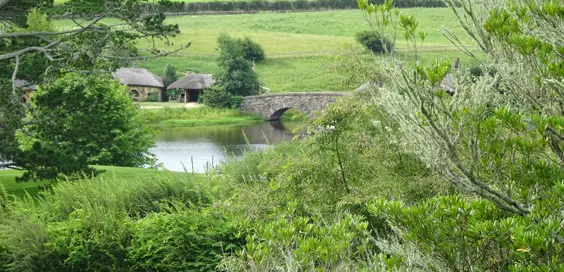






Can’t decide which journey to take first? Read @on_magazine’a review of both #TheGhan and #IndianPacific here http://t.co/p3DHmy7Z
Ghan Indian Pacific travel review An Australia Travelogue On: Magazine http://t.co/qrt1sgcl